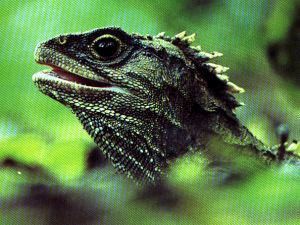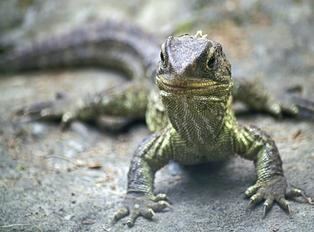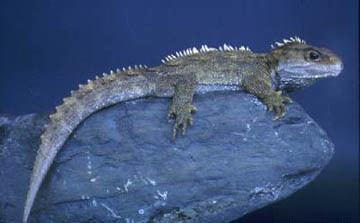Phylum Chordata Scientific name Rhynchocephalia Rank Order | ||
 | ||
Lower classifications | ||
Tuatara rhynchocephalia
Rhynchocephalia is an order of lizard-like reptiles that includes only two living species of tuatara (Sphenodon punctatus and Sphenodon guntheri), which only inhabit parts of New Zealand. Despite its current lack of diversity, the Rhynchocephalia at one time included a wide array of genera in several families and represents a lineage stretching back to the Mesozoic Era. Many of the niches occupied by lizards today were then held by sphenodontians. There were even several successful groups of aquatic sphenodontians such as pleurosaurs and the bizarre Ankylosphenodon.
Contents

Classification

Sphenodonts, and their sister group Squamata (which includes lizards, snakes and amphisbaenians), belong to the superorder Lepidosauria, the only surviving taxon within Lepidosauromorpha. Squamates and sphenodonts both show caudal autotomy (loss of the tail-tip when threatened), and have transverse cloacal slits. The origin of the sphenodonts probably lies close to the split between the Lepidosauromorpha and the Archosauromorpha. Though they resemble lizards, the similarity is superficial, because the group has several characteristics unique among reptiles. The typical lizard shape is very common for the early amniotes; the oldest known fossil of a reptile, the Hylonomus, resembles a modern lizard. R.L. Ditmars, Litt.D, says; "The Tuatara resembles in form stout-bodies modern lizards, which we might call iguanas; this resemblance is further intensified by a row of spines upon the back. It is dark olive, the sides sprinkled with pale dots. The eye has a cat-like pupil. Large specimens are two and a half feet long. While superficial resemblance might tend to group this reptile with lizards, its skeleton and anatomy show it to belong to a different part of a technical classification."

Tuatara were originally classified as lizards in 1831 when the British Museum received a skull. The genus remained misclassified until 1867, when Albert Günther of the British Museum noted features similar to birds, turtles, and crocodiles. He proposed the order Rhynchocephalia (meaning "beak head") for the tuatara and its fossil relatives. Many disparately related species were subsequently added to the Rhynchocephalia, resulting in what taxonomists call a "wastebasket taxon". Williston proposed the Sphenodontia to include only tuatara and their closest fossil relatives in 1925. Sphenodon is derived from the Greek for "wedge" (σφήν/sphen) and "tooth" (ὀδούς/odous). However, today Rhynchocephalia is used to include Gephyrosaurus and Sphenodontia, while Sphenodontia excludes the former.
The following is a cladogram of Rhynchocephalia after Rauhut et al., 2012.
